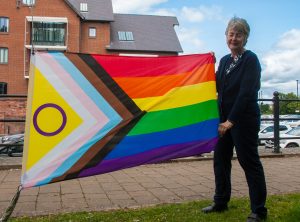June is Pride Month, a month-long global celebration. The month is usually celebrated with parades and marches, with people coming together in love and friendship.

Leader of Council Heather Kidd with the Progress Pride flag
The Council is once again taking the opportunity to publicise and promote the efforts of community activists in regard to Pride Month activities and events, as well as arrangements being made to fly the Rainbow Flag from Council offices during the month. Of those of which the Council is aware, Oswestry Pride takes place over this coming weekend, whilst Bridgnorth Pride takes place on Saturday 14 June. Shrewsbury Pride is on Saturday 27 September.
Oswestry Pride 2025 includes a parade on Saturday 7 June. The parade will begin at Cae Glas Park and process through the town. For Bridgnorth Pride 2025, people are invited to meet on 14 of June at 12pm by the Cliff Railway top station. There will then be a parade around Castle Walk and into Castle Grounds.
Councillor Heather Kidd, Leader of the Council, said:
“In Shropshire, we join in locally with celebrations of difference and diversity. As a Council, it is important for us to show respect for difference, and to show our support through the flying of the Rainbow Flag. I would like to congratulate local community Pride Event organisers for their efforts across our county, during this month and later in the year, and wish them every success.
“If you are in Shrewsbury, you will also see the Rainbow Flag flying from Shrewsbury Library. This was put up on 1st June, and was a kind donation. We will have our main Rainbow Flag, which has been in use for more than five years now, flying from 6th to 16th June.”
At Shropshire Libraries, people will be able to find LGBTQ+ interest books available on the shelves or on request from smaller branches. Shrewsbury Library has a LBGT+ collection made from donated books from SAND (Safe aging, no discrimination) which can be found on the catalogue.
There is a dedicated section on the Library Service’s free E-book CloudLibrary app which includes audiobooks and people can also access LGBTQ+ magazines through the PressReader newspaper and magazine App. In libraries, there are also displays and information on local groups such as Ludlow Gaymers at Ludlow library, or events such as Shrewsbury Pride. All of the libraries are welcoming Safe Spaces for everyone.
The Council is also making arrangements for colleagues to show their own support if they wish to do so, through using a range of optional Pride Month flag backgrounds on Teams.
Further Information
Pride Flags
In 1978, the rainbow flag was created by American artist and gay rights activist Gilbert Baker. It was first displayed on June 25th 1978, for the San Francisco Gay Freedom Parade. It was not until 1994 that the rainbow flag was truly established as the symbol for LGBT+ pride. Now the rainbow flag is an international symbol for pride and can be seen all around the world.
Baker saw the rainbow as a natural flag from the sky, so he adopted eight colours for the stripes, each colour with its own meaning. These were: hot pink for sex; red for life; orange for healing; yellow for sunlight; green for nature; turquoise for magic and art; indigo for harmony; and violet for spirit.
The flag then became a six-colour flag for mass production, partly because the fabric and dye for hot pink could not be sourced, due to production issues, and partly because removing turquoise would make the flag appear more symmetrical when hanging vertically. Turquoise was combined with Indigo, the colour for harmony.
This is the most common variant of the rainbow flag, with the red stripe on top, as in a natural rainbow. The various colours came to reflect both the immense diversity and the unity of the LGBT+ community.
In 2017, Philadelphia’s office of LGBT Affairs added black and brown stripes to the Pride flag to recognise people of colour. A year later, an artist called Daniel Quasar released a redesign called the Progress Pride flag. It included black, brown, pink, pale blue and white stripes, to represent marginalised people of colour in the LGBT+ community, as well as the trans community, and those living with HIV/AIDS.
Variants now also include the transgender pride flag: the flag was created by Monica Helms, a transgender activist and U.S. Navy veteran, in August 1999. The flag consists of three primary colours: baby blue, pink, and white. Each stripe carries significance:
- Blue – Represents boys and traditionally masculine identities.
- Pink – Represents girls and traditionally feminine identities.
- White – Symbolises non-binary, gender nonconforming, and transitioning individuals.


